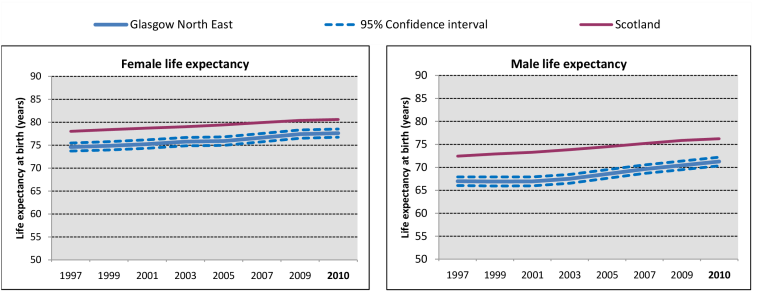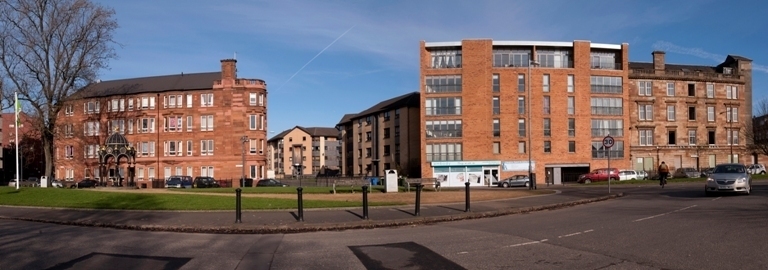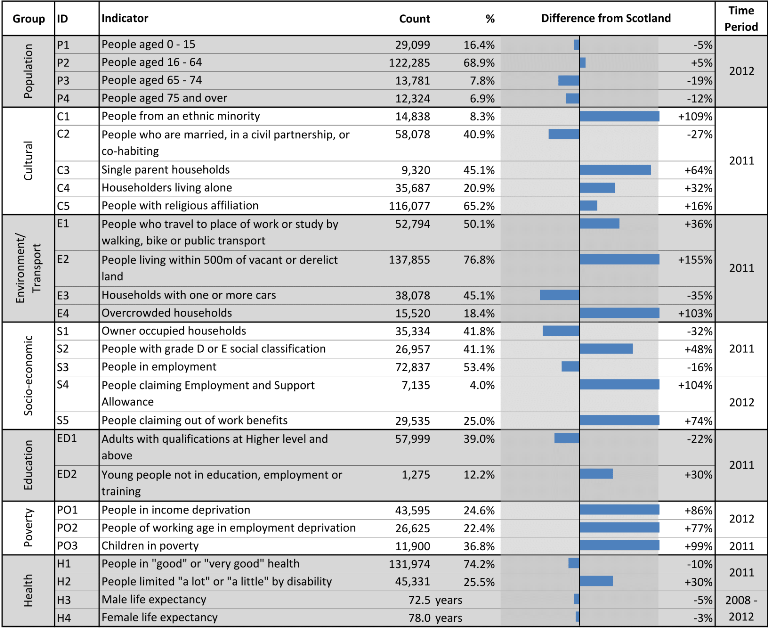NE Sector
NE Sector
Sighthill, Roystonhill and Germiston
Springburn
Balornock and Barmulloch
Robroyston and Millerston
Blackhill and Hogganfield
Ruchazie and Garthamlock
Easterhouse
Baillieston and Garrowhill
Mount Vernon and East Shettleston
Tollcross and West Shettleston
Springboig and Barlanark
Riddrie and Cranhill
Haghill and Carntyne
Dennistoun
Calton and Bridgeton
Parkhead and Dalmarnock
*Please note that this profile is based on data from the 2011 Census.*
Download a printer friendly version of this profile here
The Glasgow North East sector has a population of 177,489.
Sector comparisons with Scotland
Male and female life expectancy is slightly lower than the Glasgow average and markedly lower than the Scottish average. Women live, on average, six years longer than men. Eight per cent of the population is from an ethnic minority. Single-parent households make up 45% of all households with dependent children. Eight out of ten people live within 500m of vacant or derelict land. Twenty-five per cent of adults are claiming out-of-work benefits. Thirty-seven per cent of children live in poverty and levels of deprivation are considerably higher than the Scottish average. Twenty-six per cent of people have a limiting disability.
Sector trends
 Life expectancy for both males and females has risen in recent years in Glasgow North East but remains below the Glasgow and Scottish average. In the most recent period shown (2008-12), life expectancy was 71.3 years for men and 77.6 years for women, notably lower than the Scottish average, particularly for men.
Life expectancy for both males and females has risen in recent years in Glasgow North East but remains below the Glasgow and Scottish average. In the most recent period shown (2008-12), life expectancy was 71.3 years for men and 77.6 years for women, notably lower than the Scottish average, particularly for men.
 The population in Glasgow North East increased by 1.5% between 1996 and 2012. Within this overall trend, there was a decrease in the number of children and an increase in the working age population. The percentage of the total sector population from a minority ethnic group rose from 3% in 2001 to 8% in 2011. The percentage of the population from an ethnic minority has remained lower than the Glasgow average between 2001 and 2011, but is above the national average.
The population in Glasgow North East increased by 1.5% between 1996 and 2012. Within this overall trend, there was a decrease in the number of children and an increase in the working age population. The percentage of the total sector population from a minority ethnic group rose from 3% in 2001 to 8% in 2011. The percentage of the population from an ethnic minority has remained lower than the Glasgow average between 2001 and 2011, but is above the national average.
Notes
A document giving detailed notes and definitions for the information presented in this profile can be downloaded here.
An Excel workbook containing the data used in all of the profiles can be downloaded here. This workbook also includes alternative output formats and further breakdowns of some of the variables.
1. Data sources: Scottish Index of Multiple Deprivation (SIMD) 2012, Census 2011, Census 2001, HMRC, NOMIS, National Records of Scotland (NRS) and Scottish Government.
2. Populations presented in the population trend chart and used to calculate life expectancy estimates are taken from NRS small area population estimates and are based on: the 2001 Census for the years 1996-2001; both the 2001 and 2011 Census for the years 2002-2010; and the 2011 Census for the years 2011-2012.
3. The Income deprivation and Employment deprivation indicators are derived from SIMD 2012, more information on this deprivation index can be found at: http://simd.scotland.gov.uk/publication-2012
4. Life expectancies are calculated based on population estimates and death registrations. 95% confidence intervals have been added on the graphs to give an indication of their accuracy. The x-axes of the life expectancy graphs give the mid-year for each life expectancy estimate, e.g. 2010 represents the life expectancy estimate for the period 2008-2012.
Glasgow City Council have also produced neighbourhood profiles based on data from the 2011 Census which can be accessed via this link.

